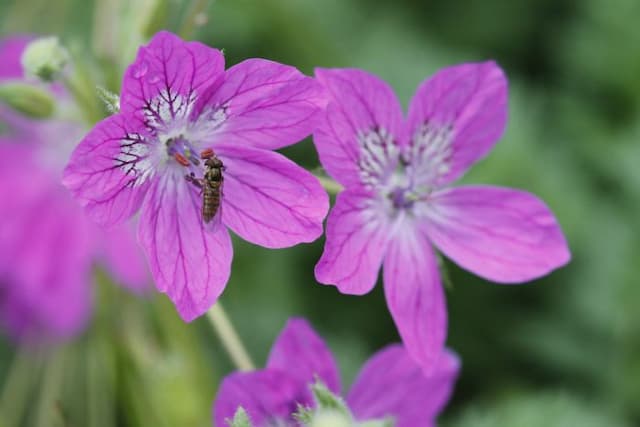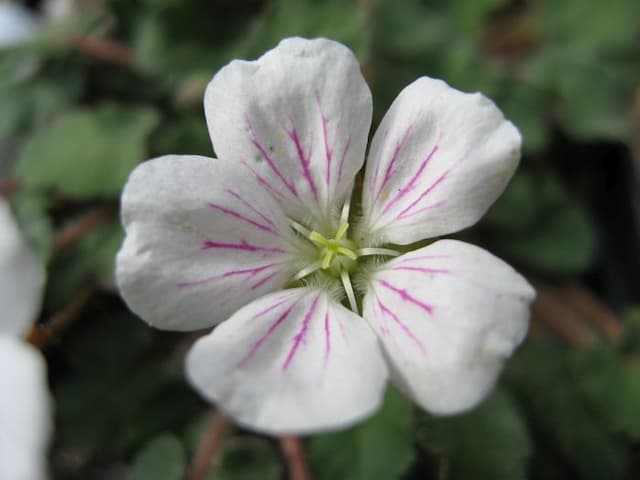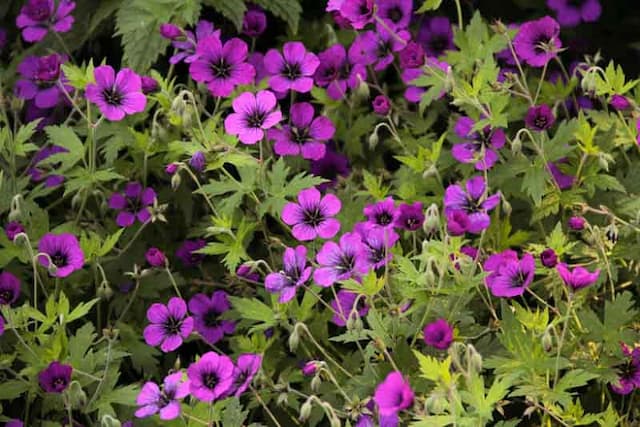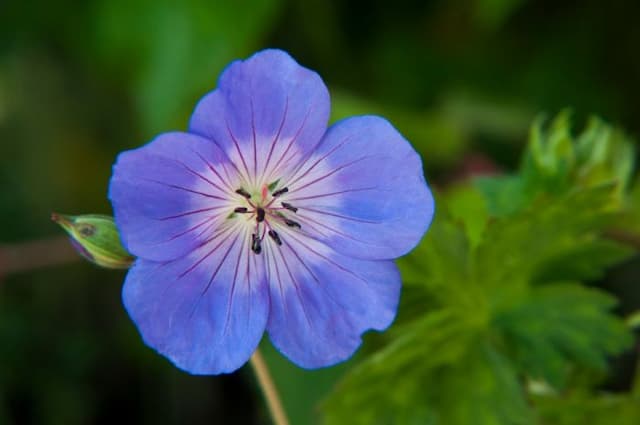Pelargonium 'Roller's Satinique' Pelargonium 'Roller's Satinique' (U)

ABOUT
'Roller's Satinique' is a spreading bushy plant to 50cm, with hairy, grey-green, palmately dissected leaves scented of eucalyptus, and clusters of small, dark-veined pink flowers
About this plant
 Names
NamesFamily
Geraniaceae
Synonyms
Satinique Geranium, Roller's Satinique Geranium
Common names
Pelargonium 'Roller's Satinique'
 Characteristics
CharacteristicsLife cycle
Perennials
Foliage type
Evergreen
Color of leaves
Green
Flower color
Varies
Height
1-2 feet (30-60 cm)
Spread
1-2 feet (30-60 cm)
Plant type
Herb
Hardiness zones
10
Native area
South Africa
Benefits
 General Benefits
General Benefits- Ornamental Appeal: Pelargonium 'Roller's Satinique', commonly known as geranium, adds visual interest to gardens with its colorful and satin-like blooms.
- Low Maintenance: Geraniums are known for being easy to care for, requiring minimal watering and fertilizing, making them ideal for gardeners of all levels.
- Drought Tolerant: Once established, this geranium is relatively tolerant to periods of drought, making it suitable for xeriscaping or gardens in arid regions.
- Pest Resistant: Geraniums have a natural resistance to many common garden pests, reducing the need for chemical pest control.
- Long Blooming Season: Geraniums typically have a lengthy blooming period, providing color and interest to outdoor spaces for much of the growing season.
- Container Gardening: This plant is well-suited to container gardening, allowing for decorative displays on patios, balconies, and other limited spaces.
- Variety of Uses: Geraniums can be used in a range of garden settings, including borders, bedding, and as companion plants in mixed containers.
 Medical Properties
Medical PropertiesThis plant is not used for medical purposes.
 Air-purifying Qualities
Air-purifying QualitiesThis plant is not specifically known for air purifying qualities.
 Other Uses
Other Uses- Potpourri Addition: The dried leaves and flowers of the scented geranium can be crushed and added to potpourri mixes for their fragrance and appearance.
- Flavoring Agent: Leaves can be infused in sugar or used to flavor jellies, desserts, and teas for a subtle, rose-like aroma.
- Natural Insect Repellant: Scented geraniums are believed to help repel mosquitos and other insects when planted around outdoor living spaces.
- Craft Projects: The attractive foliage and flowers can be used in crafting, such as making bookmarks, pressing for art, or in homemade papermaking.
- Scented Oils: The leaves can be used to create scented oils by steeping them in a carrier oil, which can then be used for aromatherapy or in homemade beauty products.
- Culinary Garnish: Edible varieties of scented geranium flowers and leaves can be used as an ornamental garnish for salads and desserts.
- Homemade Sachets: Dried scented geranium leaves and flowers can be sewn into small sachets to freshen drawers and closets.
- Natural Dye: The plant can be used to produce natural dyes for fabrics or crafting projects.
- Water Features: Floating scented geranium leaves and flowers can add fragrance and beauty to water bowls or small garden ponds.
- Environmental Education Tool: Scented geraniums can be used in educational settings to teach about the use of plants in everyday life and horticulture.
Interesting Facts
 Feng Shui
Feng ShuiThe Geranium is not used in Feng Shui practice.
 Zodiac Sign Compitability
Zodiac Sign CompitabilityThe Geranium is not used in astrology practice.
 Plant Symbolism
Plant Symbolism- Comfort: Pelargoniums are often associated with feelings of comfort due to their homey and aromatic presence in domestic gardens.
- Healing: Many pelargonium species have been used traditionally for their healing properties, implying recovery or therapeutic qualities.
- Friendship: Gifting pelargonium plants can be a symbol of friendship as they are easy to care for and long-lived like a strong friendship.
- Good Health: Their use in folk medicine to treat ailments may represent wishes for good health.
 Water
WaterGeraniums like 'Roller's Satinique' should be watered deeply but infrequently, allowing the soil to dry out slightly between waterings. Typically, watering once a week with about one gallon per plant is sufficient, but this can vary with climate, pot size, and soil type. During hot, dry spells, more frequent watering may be necessary, while in cooler, cloudy conditions, less frequent watering is required. It is important to avoid waterlogging, as geraniums do not like to sit in wet soil, which can lead to root rot. Always check the top inch of soil for dryness before watering again.
 Light
LightGeraniums such as 'Roller's Satinique' thrive best in bright, indirect sunlight. They should be placed in a spot where they receive at least 4 to 6 hours of sunlight daily. An east- or south-facing window is optimal for indoor plants, while outdoor plants benefit from morning sunlight and afternoon shade to prevent leaf scorch.
 Temperature
TemperatureGeraniums like 'Roller's Satinique' prefer temperatures between 60 and 75 degrees Fahrenheit during the day, and they can tolerate nighttime temperatures down to 55 degrees Fahrenheit. They should be kept away from cold drafts and protected from frost, as temperatures below 32 degrees Fahrenheit can be damaging. During summer, attention should be paid to ensure the plants don't overheat if outdoor temperatures rise above 85 degrees Fahrenheit.
 Pruning
PruningGeranium 'Roller's Satinique' benefits from regular pruning to promote bushy growth and remove leggy stems. Pruning should be done in early spring before new growth begins. Deadhead spent flowers regularly to encourage continuous blooming. Cutting back overgrown plants by one-third can rejuvenate them and stimulate new, fresh growth.
 Cleaning
CleaningAs needed
 Soil
SoilGeraniums like Pelargonium 'Roller's Satinique' thrive in well-draining soil with a pH between 6.0 and 7.0. A mix of one part peat, one part perlite, and one part compost is ideal for in-container growth. Regular potting soil can be improved for geraniums by adding additional perlite or coarse sand to enhance drainage.
 Repotting
RepottingGeraniums, including the Pelargonium 'Roller's Satinique', should be repotted every one to two years to refresh the soil and provide room for growth. Spring is the best time for repotting, just before the start of the active growing season.
 Humidity & Misting
Humidity & MistingGeraniums such as the Pelargonium 'Roller's Satinique' prefer moderate humidity levels. Aim for a range around 50% relative humidity, as overly humid conditions can lead to fungal diseases and pest problems.
 Suitable locations
Suitable locationsIndoor
Place in bright light, water when dry, fertilize biweekly.
Outdoor
Full sun to part shade, well-draining soil, water moderately.
Hardiness zone
10-11 USDA
 Life cycle
Life cycleThe life cycle of Pelargonium 'Roller's Satinique', commonly known as Roller's Satinique Geranium, begins with seed germination, where the seeds require warm temperatures and light to sprout. Once germinated, the seedlings grow into young plants, developing a root system and foliage. As the plant matures, it enters the vegetative stage, producing lush leaves and branching stems. When environmental conditions are favorable, typically in late spring to summer, the plant enters the blooming stage, producing clusters of satiny flowers that can be deadheaded to encourage continuous blooming. After the flowering season, Roller's Satinique Geranium may enter a dormant phase, particularly in cooler climates, where it conserves energy for the next growing season. With the return of warmer temperatures and appropriate care, the plant can exit dormancy, resuming growth and completing the cycle again.
 Propogation
PropogationPropogation time
Spring-Early Summer
The most popular method of propagating Pelargonium 'Roller's Satinique', also known as scented geranium, is through stem cuttings. This process is best done in late spring to early summer when the plant is actively growing. Select a healthy, non-flowering stem and cut a 4 to 6 inch (about 10 to 15 centimeters) length just below a leaf node. Remove the bottom leaves and dip the cut end into a rooting hormone powder to encourage root growth. Plant the cutting in a pot with moist, well-draining soil, ensuring that a few leaf nodes are buried where roots and new growth will emerge. Cover the pot with plastic to create a greenhouse-like environment, keeping the cutting in bright, indirect light until it roots in a few weeks, after which you can remove the plastic and care for it as a regular plant.









![Cranesbill [Rothbury Gem]](/_next/image?url=https%3A%2F%2Fplants-admin.emdemapps.com%2Fimages%2Fplants%2F%2Fimages%2F604b6243984c2.png&w=640&q=75)